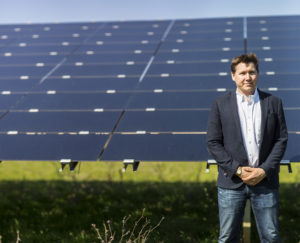
Warrington Borough Council has signed a huge solar plus battery storage deal, enabling it to generate all of its electricity and make millions of pounds a year in profit.
Both the council and Gridserve, the company behind the project, believe it creates a blueprint for other local authorities to follow.
Warrington will pay £62.3m for two solar farms totalling 60.4MW plus 27MW battery storage.
The battery will be co-located with a 34.7MWp solar farm at York. Construction work will commence “imminently” according to Gridserve. A second 25.7MWp solar farm at Hull is due to follow, with plans to add a battery at a later date.
Blueprint
The council will take ownership of the projects once completed. By supplying or ‘sleeving in’ its own power, Warrington will lock in prices and cut its bills by around £2m a year. It expects to make £150m in surplus from the solar farms over 30 years, which will be fed back into frontline services. Gridserve, founded by former CEO and co-founder of Belectric, Toddington Harper, will continue to operate the assets.
Leader of Warrington Borough Council, Cllr Russ Bowden, said local authorities have a pivotal role to play in decarbonising the economy. He urged other councils to emulate the “working model” its projects have created, deemed by the Association for Public Service Excellence (APSE) as ‘prudent, commercially viable and of high investment grade’.
Gridserve’s Harper said it was “very likely” more councils will follow suit. He believes the subsidy-free model is “genuinely sustainable and delivers multiple wins for everybody”.
No subsidy, no limits
Since selling Belectric, Harper has been working to make unsubsidised solar viable. He thinks the Warrington deal represents a watershed moment.
“Previously, everything was driven by a subsidy, a pot, a target. All of a sudden we don’t have any of that, we are limited merely by the extent of our ambition.”
That means “no more scrabbling in mid-winter mud, racing to finish projects” to hit a subsidy-driven deadline. Crucially, he said, it requires “much greater intelligence” around how the power is used.
“In the subsidy environment, projects were designed around those subsidies. There was not a great amount of attention about the energy itself once it went into the grid.”
That led to imbalances and inefficiencies, which require further actions and payment to correct.
“That’s not particularly clever,” said Harper. “If we are going to have an infrastructure based primarily on renewable energy, you have to make projects part of the solution.”
Smarter systems
Without subsidies, solutions must also be more efficient to wring out maximum value. At Warrington, Gridserve thinks it will deliver 20 per cent more power by combining bifacial panels and tracking technology.
Bifacial panels generate energy on both sides – from ambient light on the back, from daylight on the front. Trackers rotate the PV panels from east to west, smoothing out generation curves throughout the day.
That is important in a world where income is market-driven, said Harper.
“Subsidy-type solar farms, designed for index-linked returns rather than grid impact, will typically have panels facing south and typically achieve highest output around noon,” said Harper.
“Without subsidy, in a system driven by supply and demand, exporting power to the grid when everybody else is exporting means prices will fall – and that’s not particularly helpful to the system.
“So the trackers and the bifacials enable us to generate a little more power and generate it more evenly throughout the day. There is still a curve, but it is much flatter, and it generates additional [financial] benefit as well as benefit to the grid.”
Adding a battery enables Warrington to spread the load further, and potentially export more at peak times, or whenever the system needs it most.
Grid services
The import-export connection means Warrington can also draw power from the grid – for example when there is too much wind, or too little demand on the transmission system (demand-turn up), a growing challenge for National Grid.
“Batteries can provide any grid services – frequency, reactive power, Black Start, a whole combination of things,” said Harper.
“But even without securing contracts from National Grid, or ultimately distribution system operators (DSOs), you can just time shift when it makes sense. That is why we are called Gridserve. We aim to help the grid – and that is what we mean by ‘sustainable’ energy above ‘renewable’ energy.”
Harper said Gridserve has been conservative in its modelling for York and Hull and could ultimately end up making money for the council in many more ways.
“We have actually put a lot of potential revenue lines at zero. That way, when we over deliver, everybody is happy. But anything is possible. We can do much more with these projects than we are forecasting.”
Electric vehicles
Gridserve ultimately hopes to create ‘electric forecourts’ linked to both Warrington sites, enabling ‘supercharging’ for up to 24 electric vehicles simultaneously, according to Gridserve’s press release. Chief executive Toddington Harper wouldn’t be drawn on the firm’s EV plans, but said the company will make more detailed announcements “in the next month or so”.
Related stories:
London calling for £500m energy contract
Drax chief: more volatility, more profit
As solar generation makes history, National Grid starts to feel the burn
Onsite generation ‘will continue to boom’
Ashford council eyes £7m income from solar farm
Click here to see if you qualify for a free subscription to the print edition or to renew.
Follow us at @EnergystMedia. For regular bulletins, sign up for the free newsletter.




Why is the physical project going to be located in York, when Warrington is in Cheshire?